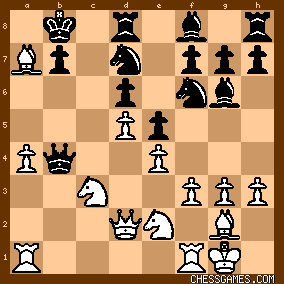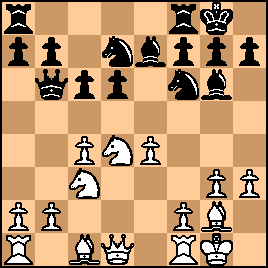| May-21-04 | | fred lennox: 9...0-0-0 is not sound. Be7 with 0-0, Re8, Nf8 offers a solid, somewhat cramp position but not without targets. |
|
| Apr-25-09 | | notyetagm: 24 ?

click for larger view24 ♗e3xa7+!

click for larger view(VAR)
24 ... ♔b8x♗a7?? 25 ♘c3-b5+ <discovered attack: b4>

click for larger view |
|
Sep-06-09
 | | plang: 3..Bf5 is a move one is not likely to see nowadays as it is illogical. 4 f3 would have been an alternative valid response. I wonder if 10..c5 might have been playable though White is still clearly better. Alekhine pointed out that 16 Rab1 followed by Qd2 and Rfc1 would have been even stronger. 23..Nxb3 would have been answered by 24 a6! and if 24..Nxd2? then 25 axb+ mates. |
|
| Feb-26-10 | | echector: A paradox of this game is that an undeveloped light squared bishop may well be better posted than a developed bishop at f5 or g6 |
|
| Nov-12-10 | | Knight13: <fred lennox: 9...0-0-0 is not sound. Be7 with 0-0, Re8, Nf8 offers a solid, somewhat cramp position but not without targets.> Yes, 9...O-O-O plays right into White's hands. White's attack is faster. But you know Janowski---he loves to attack at the expense of what the position calls for him to do. So 9...O-O-O was only natural. Except that he didn't even get to push his kindside pawns to start his attack! |
|
Feb-11-13
 | | perfidious: <plang: 3..Bf5 is a move one is not likely to see nowadays as it is illogical....> The line is not objectively strongest, but that never stopped Kamran Shirazi from playing it against even the toughest players: http://www.chessgames.com/perl/ches... In our last encounter, at Philadelphia 1993, I opened 1.c4, so he never got the chance. |
|
| Oct-06-21 | | Gaito: Instead of 9...O-O-O? Alekhine suggested 9...Be7 10.Be3 Qc7, but another alternative for Black was 9...exd4 10.Nxd4 Be7 11.O-O O-O with a healthy (albeit somewhat cramped) position. See diagram below:

click for larger view |
|
| Oct-06-21 | | Gaito: 10.d5 was a clever positional move, with the simple plan of making the Q-side the main theater of operations, where White will have a bunch of extra pieces. Several black pieces will be condemned to remain out of the scene of action for a long time, maybe for the rest of the game, so it will be a pleasure for Alekhine to undertake an attack against the enemy king with a lot of extra material. True, 10.d5 had the drawback of giving up the square c5, but as Bobby Fischer once said: "If you want to get squares you have to give up squares".
Worthy of consideration was also 10.Be3, a move that the engines seem to like very much. Stockfish assigns an evaluation of +3.83 to the move 10.Be3, but 10.d5 gets a similar evaluation, maybe just a little lower. After 10.d5 White's game plays itself because, as stated above, he will have a lot of extra material on the Q-side. Black's two bishops will remain as ornamental figures for a long time, and so will Black's Queen's Rook. This game could be very instructive for a child or for a student who is just learning the elements of chess strategy. Giving Alekhine odds of three pieces was certainly not a good business. |
|
| Oct-06-21 | | Gaito: 
click for larger view
BLACK TO MOVE
Of course, 12...Qxb2? would have been fatal for Black, e.g. 13.Bxc5 (13.Rb1 is equally good, maybe even stronger) dxc5 14.Qa4 Qb6 15.f4 exf4 16.gxf4 Nd7 17.Rfc1 with a winning advantage for White. See diagram below:

click for larger view |
|
| Oct-06-21 | | Gaito: 13.f3!! was a stellar positional move, quite in the style of Karpov but almost 50 years before Karpov: "A small step for a pawn, but a giant positional leap for White". This little pawn advance suddenly makes almost all of Black's pieces look ridiculous! See diagram:

click for larger viewTerrific stuff! |
|
| Oct-06-21 | | Gaito: A curiosity: Alekhine criticized his own move 15.a4: "this is lack of precision, which permits the opponent to to regain control of c4 and in that way to resist a while longer. 15.Qd2 Qc4 16.Rab1 follwed by 17.Rfc1 would have deprived him even of this last chance". I find this statement to be a curiosity because: 1) 15.a4 is a move that the engines like very much. Stockfish 14 assigns an evaluation of +7.99 to that move, and 2) I suspect that Alekhine was reluctant to criticizing his own moves in games that he had won. I don't recall many instances of Alekhine criticizing his own moves in games that he won, especially when he won in such a brilliant manner. But maybe I am mistaken... |
|
| Oct-06-21 | | Gaito: 
click for larger view
In connection with the position of the diagram Alekhine's comment is both nice and interesting: "Black has weathered the first onset successfully; but inasmuch as White can attack the hostile King with all of his seven pieces, while Black's King's side is wholly undeveloped and his QB has long forgotten that he is able to move, it is only a question of time when White must win". |
|
| Oct-06-21 | | Gaito: 
click for larger view
This was the position before White's 21st move. White has an overwhelming advantage (Computer evaluation by SF14 is +10.01), yet the game lasted another 20 moves before Black resigned; so the question arises: Was there a quicker way for White to win?
Alekhine played 21.a5 bringing another unit into the attack, which is a logical move. Perhaps 21.Rab1 was also worthy of consideration, but there was no need for White to hurry up because 1) Black has zero possibilities of counterplay in a short term, and 2) Black's two bishops and King's Rook are not participating in the scene of the struggle, they are merely passive spectators and it is hard to imagine how those three pieces could possibly be of any help either in the defense of Black's attacked King or in organizing any possible counter offensive against White's King.
Very likely Alekhine was relishing and enjoying his position, and so he did not have the intention of forcing matters as quickly as possible. Professional chess players also have the right to enjoy their job! After 21.Rab1, there could have followed Nfd7 22.Rxc5! Nxc5 23.Nb5 Qb6 24.a5! and Black could resign, as he loses the Queen and his King will presently be checkmated. See diagram below:

click for larger view |
|
| Oct-06-21 | | Gaito: This very good game was played during the sixth round of the tournament, but unfortunately it somehow went unnoticed, because it was outshined or overshadowed by another game played in a neighboring table where the current World Champion Capablanca displayed his artistry in a masterfully conducted rook ending that has since become famous and appears in all books devoted to the endgame as a text-book example on how those endings should be played. In the book of the tournament Hermann Helms wrote brief abstracts of each game at the beginning of each round. Regarding the Alekhine vs. Janowsky game he wrote the following paragraph: "...... a game that was mismanaged strategically by Janowsky, who castled on the Queen's side in the face of a grilling attack promptly worked up by Alekhine. The Black QB remained out of the game after six moves." |
|
| Oct-06-21 | | RookFile: Let's castle queenside and use the queen as a defender against rooks, and see what happens. Interesting strategy. |
|





